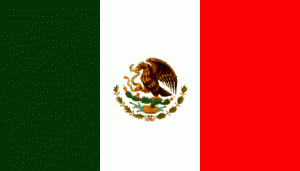
Mexico
Quick reference
General issues: Federal republic 1856-1864, Empire 1864-1867, Federal republic 1867-Present
Country name on general issues: Mejico, Mexico
Special issues:
- Republican issues 1864
- Mexican Revolution:
- State issues Sonora, Constitutionalist 1913
- State issues Sonora, Conventionalist 1914-1915
- State issues Baja California 1915
- State issues Oaxaca 1915
- Constitutionalist issues 1913-1915
- Conventionalist issues 1914
- Provisional government issues 1915-1916
- Local Constitutionalist issues 1914-1915: Acambaro 1914, Aguascalientes 1914, Chihuahua 1914, Ciudad González 1914, Colima 1914, Culiacán 1914, Guayamas 1915, León 1914, Matehuala 1914, Monterrey 1914, Baja California South 1915, Salamanca 1914, San Louis Potosi 1914, Sinaloa 1914, Sonora 1914, Torreón 1914, Zacatecas 1914
- Local issues: Campeche 1877-1878, Chiapas 1867, Cuautla 1867, Cuernavaca 1867, Guadalajara 1867-1868, Merida 1916, Tlacotalpan 1856
- Insurgent issues: Yucatan 1924, Sinaloa 1929
Currency: 1 Peso = 8 Reales = 100 Centavos 1856-1993, 1 Peso = 100 Centavos 1993-Present
Population: 13 607 000 in 1900, 122 300 300 in 2013
Political history Mexico
Colonization and independence
Mexico is located in Central America. Prior to colonization, Mexico was inhabited by a number of advanced Amerindian civilizations. Some of the major archaeological sites found in Mexico date back to the first millennium: Teotihuacan in central Mexico and the Mayan city of Chichen Itza in Yucatan. In the second millennium the Aztec rose to power in central Mexico – their capital was Tenochtitlan at the location of modern day Mexico City. The first Europeans to explore Mexico were the Spanish in 1518. Colonization started in 1519, and in 1521 the Spanish conquered the Aztec capital of Tenochtitlan. Although the Spanish had thus established themselves in central Mexico, establishing effective colonial rule in all of Mexico would take more than two centuries. Mexico, during the colonial period, was ruled as the Viceroyalty of New Spain.
When Napoleon had conquered Spain, independence movements spread across the Spanish possessions in the Americas. In 1810, Miguel Hidalgo y Costilla would be the first to appeal for Mexican independence. The war of independence that ensued would last until 1821, when independence was achieved. The First Empire of Mexico was established and Agustín de Iturbe assumed the throne as emperor Agustín I. The First Empire was short lived. The emperor was deposed in 1823 and Mexico became a federal republic formally known as the United States of Mexico. The provinces of the former Captaincy General of Guatemala – most of Central America – had joined the Mexican empire in 1821, but, with the exception of the province of Chiapas, seceded in 1823 to become independent states. Chiapas voted to join the United States of Mexico. The district of Socunusco joined Mexico in 1842. Guatemala long claimed both Chiapas and Socunusco. The dispute was settled through a border agreement signed in 1882.
Mexico in the 19th century
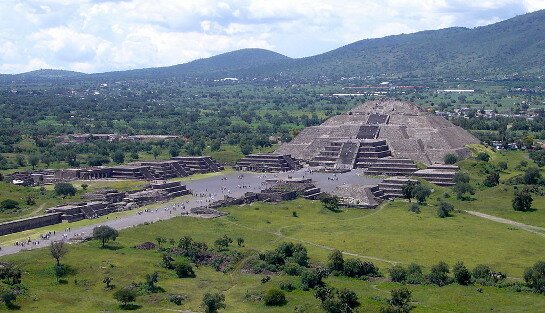
Teotihuacan is the most visited archeological site in Mexico. The city of Teotihuacan was at its height between 100 AD and 500 AD. Little is known about the people that built the city.
The first decades after independence were a turbulent phase in Mexican history. Liberals and conservatives disputed the form of government: the liberals advocated a federal government, while the conservatives opted for a central government. Power would change hands several times, often after an armed conflict. Several individual states broke away as independent republics, most often temporarily. One of these was the republic of Texas, that proclaimed independence in 1837. Texas, however, opted not to return to Mexico but to become part of the United States in 1845. Texas had claimed a large part of the Mexican territory of New Mexico. The settlement of the border between Mexico and the United States, after Texas had joined the United States, sparked the Mexican-American War from 1846 to 1848. The war ended in victory for the United States – Mexico was forced to cede large parts of its territory. The final border with the United States was established after the Gadsden Purchase in 1853.
The French intervened in Mexico in 1838-1839 to protect the right of French citizens established in Mexico. In 1861 the French intervened again. Now, though, the French aimed to bring Mexico within the French sphere of influence. Supported by a number of factions in Mexico, the French gained control of Mexico by 1864 and established the Second Empire. The Habsburg archduke Ferdinand Maximilian assumed the throne as emperor Maxilimian I. Republican forces ousted the emperor in 1867 and restored the republic – the Second Mexican Republic.
The Porfiriato and the Mexican Revolution
After five decades of turbulence, a period of stability started with the rule of president Porfirio Díaz in 1876. Díaz would rule the country until 1911. His dictatorial rule provided political stability and economic growth, but at a high social cost. In the first decade of the 20th century the opposition against Díaz grew and became organized. The opposition took up arms in 1910, sparking what is probably the most violent period in Mexican history, that of the Mexican Revolution. In 1913, after a military coup, the constitution was suspended and the Mexican Revolution turned into nation wide civil war that would last until 1917 when a new constitution was adopted and Mexico returned to a constitutional presidency. For a more detailed discussion of the Mexican Revolution, please refer to the separate profile Mexico – Mexican Revolution.
Mexico in the 20th century
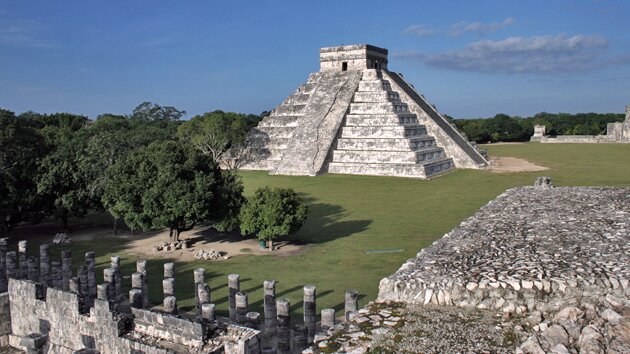
Chichen Itza was one of the major Mayan cities between 600 AD and 1200 AD
With the end of the Mexican Revolution, stability was not achieved. From 1917 until 1929, the presidency changed hands several times – often after renewed armed conflicts. In different parts of the country factions would revolt against the federal government. Stability was finally achieved in 1929 when the Partido Nacional Revolutionario, the PNR, was formed and gained the presidency. The PNR would rule Mexico for the next seven decades. First as the Partido Nacional Revolucionario, then as the Partido de la Revolucion Mexicana and finally as the Partido Revolutionario Institucional, the PRI. The PRI lost the 2000 elections and was succeeded by the Partido Acción Nacional. In 2012, the PRI regained the presidency. The long period of one party rule provided political stability, but also, at times, led to political repression.
Currently, a major challenge for the Mexican government is the Mexican War on Drugs. When the large drug cartels in Colombia were dismantled in the 1990’s, drug production and trafficking increasingly shifted to Mexico. Powerful cartels developed, now in Mexico. The war escalated in 2007 with the death toll increasing from over 2 000 in 2007 to over 18 000 in 2011. The government, until today, has not been able to dismantle the cartels.
Economics and demography
Economically, Mexico has known a period of continuous growth from 1930 until 1970 – sometimes called the ‘Mexican Miracle’. Since 1970, though, Mexico faced several periods of recession. Since the signing of the North American Free Trade Agreement – NAFTA – in 1994, the Mexican economy, focusing increasingly on manufacturing, is once again in an upswing. Mexico ranks among the 15 largest economies in the world. The largest population group are the mestizo – people of mixed Amerindian and European offspring – at 62% of the population. The indigenous Amerindian peoples account for 15% of the population.
Postal history Mexico
General issues, district overprints and foreign offices
The first stamps in Mexico were issued in 1856 by the First Mexican Republic. This first set, and most sets issued until 1884, show the portrait of Miguel Hidalgo y Costilla, the father of Mexican independence. Under the aegis of the Second Empire of Mexico, a first set is issued in 1864 – the ‘Eagles’ issue. A subsequent set shows the portrait of emperor Maximilian. After the downfall of the Empire, the Second Republic has issued stamps from 1867. The first issue is provisional and the first definitives appear in 1868.
From 1856 until 1882, Mexican stamps were validated with an overprint applied upon receipt of a consignment at the district post office. Different overprints have been used at different times. Elements in the overprints were: the district name, the district number, the consignment number and the year of issue. What elements were to be used varied over time. With over 50 districts, hundreds of consignments and 18 years in which the overprints were issued, the classical period of Mexican philately – 1856 to 1882 – is probably the ultimate specialists domain. An in depth discussion of the district overprints may be found on the following webpages: Mexican Hidalgo Issues and Mexican Eagles.
British offices operated in Tampico and Vera Cruz, using British stamps from 1865 to 1876. French offices operated at Matamaros, Tampico in 1866-1867 and in Vera Cruz from 1862 to 1879, using French stamps. These foreign offices would have handled most foreign mail until Mexico joined the UPU in 1879.
Mexico has issued, from the first issue until the present day, stamps with themes of national interest. A challenge for collectors are the long running series that Mexico has issued in the modern era: the ‘Mexican Culture’ series, running from 1950 until 1976, the ‘Exporta’ series running from 1975 to 1992 and the ‘Tourism’ series running from 1993 to 2001. The stamps from these series were issued in many variations of watermark, perforation, paper and type of print – another domain for specialists in Mexican philately.
Special issues
-
During the reign of Maximilian, most, but not all, of Mexico was under control of the imperial and French forces. The republican government in 1864 issued stamps for use in the areas it then controlled. This issue, called the ‘Monterrey’ issue, is known to be used in two cities in northern Mexico, Monterrey and Saltillo. Aside from these general issues, local issues have appeared both in areas under imperial and areas under republican control. These local issues are outside the scope of the worldwide catalogs. During the transition from the Empire to the Second Republic, local provisionals were issued in 1867 and 1868 in the cities of Cuautla, Cuernavaca and Guadalajara and the state of Chiapas.
- The period of the Mexican Revolution has, between 1913 and 1916, led to a large number of special issues: by the Constitutionalists and the Conventionists, by individual states and by the provisional government. For a more detailed discussion of the issues from this period, please refer to the separate profile: Mexico – Mexican Revolution.
- The political instability, that continued after the Mexican Revolution, resulted in two special issues in the 1920’s:
- The first appears in the state of Yucatan in 1924. In 1923, Adolf de la Huerta took up arms against the presidency of Plutarco Elias Calles. Yucatan sided with De la Huerta and established a revolutionary government. The government was short lived. Obregon, the strongman behind Calles, in January 1924, defeated De la Huerta and subsequently put an end to the rebellion in Yucatan in May 1924. The stamps issued are inscribed ‘Mexico, Gobierno Revolucionario’.
- A further special issue appeared in 1929 in the state of Sinaloa. In March 1929, Jose Gonzalo Escobar started a rebellion against the federal government, effective mainly in the northern states of Mexico. Sinaloa was one of these states. The rebellion lasted about three months before it was crushed by the federal army. The stamps issued are inscribed ‘Ejercito Renovador'[1]‘Army of Renewal’ , which was the name of the army led by Escobar. The stamps were printed, but not used before the rebellion was crushed.
- Local issues have appeared in the city of Tlacotalpan in 1856, in the state of Campeche in 1877-1878 and in the city of Merida in 1916.
Album pages
← Previous page: MartiniqueNext page: Mexico - Mexican Revolution →

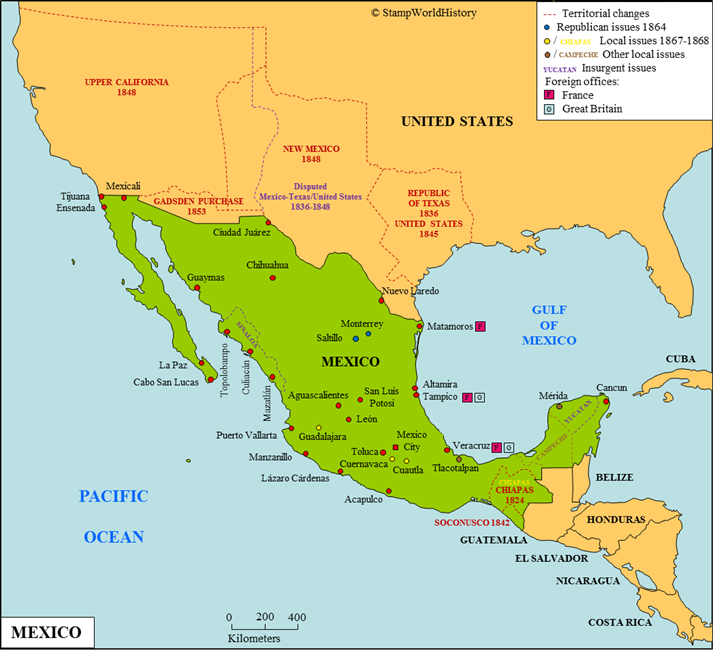
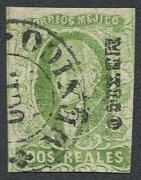
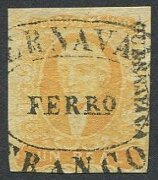
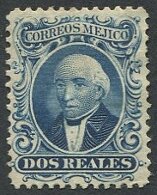
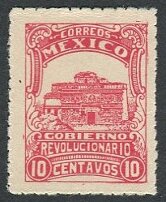






Gerben,
I have information about Mexico districts overprints 1856-82 that may interest you. This information is from very good website in internet. Pity this website disappeared from internet few years ago.
Overprints without the names of the districts consist of 4(3) digital overprints. The last two digits are shortened inscriptions of the overprints years (68=1868 etc.). First two (one) digits are the code of the district. The codes of the districts were not steady, they were changed every four years. Example. Code of Zacatecas was 20 in 1865, 13 in 1868-1872, 51 in 1872-1877 and 2 in 1878-1883. Are you interesting in the list of the districts codes? It makes possible to establish overprinting district when the overprint is without the name of the district. Gedi
Gedi
Thanks for this nice bit of extra information. And yes, I would certainly be interested in the list.